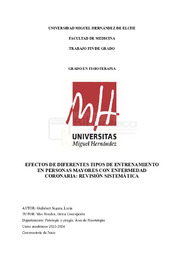Título :
Efectos de diferentes tipos de entrenamiento en personas mayores con enfermedad coronaria: revisión sistemática |
Autor :
Guilabert Segura, Lucía |
Tutor:
Mas Penalva, Gema Concepción |
Editor :
Universidad Miguel Hernández |
Departamento:
Departamentos de la UMH::Patología y Cirugía |
Fecha de publicación:
2024-05-31 |
URI :
https://hdl.handle.net/11000/33589 |
Resumen :
Introducción: La enfermedad de las arterias coronarias (EAC) es la principal causa de muerte en los
países occidentales. Factores de riesgo asociados, envejecimiento y sedentarismo están contribuyendo
a la creciente prevalencia de sarcopenia y fragilidad en estos pacientes. El entrenamiento continuo de
moderada intensidad (MICT) es el más empleado en la actualidad en los programas de rehabilitación
cardíaca (PRC); sin embargo, son pocos los estudios que comparan los efectos que producen las
diferentes modalidades de entrenamiento en las personas de edad avanzada.
Objetivo: Conocer la evidencia científica de diferentes entrenamientos en personas mayores con
enfermedad coronaria y comparar sus efectos, para aportar en el futuro nuevas propuestas de
tratamiento a estos pacientes.
Metodología: La revisión bibliográfica se llevó a cabo mediante búsqueda electrónica en las bases de
datos Pubmed, Web of science, Scopus y Dialnet. Tras aplicar diferentes criterios de inclusión y
exclusión se seleccionaron 15 artículos.
Resultados: El método interválico de alta intensidad (HIIT) aporta una mejora en datos
antropométricos y VO2 máximo respecto al MICT. Por otro lado, el entrenamiento de fuerza (RT)
demostró mejoras en la salud muscular y calidad de vida, especialmente combinado con el HIIT.
Además, se incluyen otros métodos innovadores que demuestran mejoras significativas.
Conclusiones: Todos los entrenamientos aportan beneficios, siendo la combinación HIIT-RT más
ejercicios de equilibrio la que parece más indicada para esta población. Sin embargo, resulta
complicado comparar los resultados obtenidos dada la falta de homogeneidad en los protocolos
utilizados.
Introduction: Coronary artery disease (CAD) is the leading cause of death in Western countries.
Associated risk factors, aging and sedentary lifestyle are contributing to the increasing prevalence of
sarcopenia and frailty in these patients. Moderate intensity continuous training (MICT) is currently the
most used in cardiac rehabilitation (PRC) programs. However, there are few studies that compare the
effects produced by different training modalities in elderly people.
Objectives: To know the scientific evidence of different training in older people with coronary heart
disease and compare their effects, to provide new treatment proposals for these patients in the future.
Methodology: The bibliographic review was carried out through an electronic search in the Pubmed,
Web of science, Scopus and Dialnet databases. After applying different inclusion and exclusion
criteria, 15 articles were selected.
Results: The high intensity interval method (HIIT) provides an improvement in anthropometric data
and maximum VO2 compared to the MICT. On the other hand, strength training (RT) demonstrated
improvements in muscle health and quality of life, especially combined with HIIT. Additionally, other
innovative methods are included that demonstrate significant improvements.
Conclusions: All workouts provide benefits, with the HIIT-RT combination plus balance exercises
being the one that seems most suitable for this population. However, it is difficult to compare the
results obtained given the lack of homogeneity in the protocols used.
|
Palabras clave/Materias:
Envejecido
Ejercicio
Rehabilitación cardiaca
Isquemia miocárdica |
Área de conocimiento :
CDU: Ciencias aplicadas |
Tipo de documento :
info:eu-repo/semantics/bachelorThesis |
Derechos de acceso:
info:eu-repo/semantics/openAccess
Attribution-NonCommercial-NoDerivatives 4.0 Internacional |
Aparece en las colecciones:
TFG - Fisioterapia
|
 La licencia se describe como: Atribución-NonComercial-NoDerivada 4.0 Internacional.
La licencia se describe como: Atribución-NonComercial-NoDerivada 4.0 Internacional.
.png)
